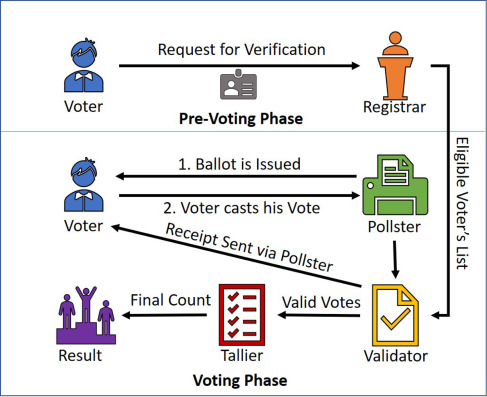E-Voting System Based on Blockchain-24
E-Voting System Based on Blockchain
As nations look to modernize and streamline their democratic processes, the idea of electronic voting, or e-voting, has gained popularity in recent years. But security, openness, and confidence issues plague conventional e-voting systems frequently. A potential remedy for these issues is provided by an e-voting system based on blockchain technology, which is well-known for being decentralized and unchangeable.
Unprecedented levels of security, transparency, and integrity are provided by the incorporation of blockchain technology into electronic voting systems. Through the use of distributed ledger technology, every vote is transparently and tamper-resistantly recorded across several network nodes. By doing this, you may be sure that every vote is genuine and prevent attempts to falsify or alter the election results.

In addition, blockchain-based electronic voting systems do away with the need for middlemen like election commissions or centralized authorities, which lowers the possibility of fraud and improves voting efficiency overall. Election accessibility and inclusivity have increased since voters can safely cast their ballots from any location with an internet connection, removing geographical restrictions.
In this work, we discuss the architecture and deployment of a blockchain-based electronic voting system. We examine the basic ideas behind blockchain technology, how it can be used for electronic voting, and the security, accessibility, and transparency advantages it provides. Furthermore, we go over the difficulties and factors to be taken into account when implementing blockchain-based electronic voting systems on a broad scale, and we suggest possible solutions to these problems.
We hope to enable citizens to engage in democracy with confidence and trust in the integrity of the voting process by utilizing blockchain technology to create a more safe, transparent, and inclusive electoral process.
Follow our Digiknowledge.co.in page for the latest updates about bikes, cars, sports, lifestyle, and many more.
The Essential Ideas of Blockchain
Transaction security, immutability, and transparency are guaranteed by blockchain technology, which is a distributed, decentralized ledger. Among the core ideas underlying blockchain are:
Decentralization: A peer-to-peer network on which every node keeps a copy of the complete ledger is how blockchain functions in place of a central authority managing the system.An immutable transaction is one that cannot be changed or removed from the blockchain once it has been confirmed.
By doing this, the blockchain’s data integrity and dependability are guaranteed. Accountability and openness are fostered by the fact that all blockchain transactions are visible to all network users.
Security: To protect transactions from unauthorized access or manipulation, blockchain employs cryptographic mechanisms.
Ethereum and Electronic Voting
Several advantages arise from incorporating blockchain technology into electronic voting systems:
Security: Because blockchain technology is decentralized, votes are safely recorded and unchangeable. Voter fraud, including vote manipulation and duplicate voting, is prevented.
Transparency: The voting process becomes transparent and the election’s integrity is maintained since every transaction is posted on the blockchain and accessible to all participants. Everyone who casts a ballot can confirm that it has been recorded correctly.
Accessibility: By enabling voters to cast ballots remotely from any location with an internet connection, blockchain-based electronic voting systems augment accessibility and boost voter engagement. People with mobility impairments or those who live in distant places will especially benefit from this.
Planning and Execution
A blockchain-based electronic voting system’s architecture and execution require several essential elements:
Blockchain Infrastructure: Ethereum or Hyperledger Fabric are two examples of appropriate blockchain platforms that are used to set up a blockchain network. To provide security and transparency during the voting process, smart contracts are used.
Voter Registration: In order to authenticate voters and stop fraudulent registrations, a secure voter registration system is put into place. Every voter receives a distinct digital identity that is kept on the blockchain.
Procedure for Voting: Through the use of an intuitive interface, voters electronically cast their ballots. To ensure anonymity and integrity, the votes are encrypted and registered on the blockchain.
Vote Counting: Smart contracts are used to total the votes after the voting time has ended. Every network member can independently verify the results, which are calculated in an open manner.
Auditing and Verification: To guarantee the fairness of the voting process, independent observers audit and verify the election results.
Problems and Things to Think About
Although implementing blockchain-based electronic voting systems has advantages, there are a number of issues and factors to take into account.
Scalability: Large-scale blockchain elections with millions of voters provide a particular problem in terms of scalability. For blockchain networks to manage extensive voting procedures, performance optimization efforts are required.
Despite the inherent security provided by blockchain technology, there are security threats that could compromise the integrity of the voting process, such as 51% attacks or smart contract issues. Ensuring the safety of these risks requires frequent audits and strong security measures.
Regulatory Conformance: Electronic voting platforms have to abide by the laws and rules that now govern elections. It is a difficult task to ensure regulatory compliance while preserving blockchain’s decentralized architecture.User adoption: In order for e-voting to be widely adopted, voters must be informed about blockchain technology, and the system must be trusted. Voter involvement can only be increased with user-friendly interfaces and open communication.
Finally, the development and deployment of an electronic voting system based on blockchain technology has a number of benefits with regard to accessibility, security, and transparency. To achieve the full potential of blockchain in transforming the election process, however, issues including scalability, security concerns, regulatory compliance, and user adoption must be resolved.
What are smart contracts in blockchain?
A smart contract is a digital contract that is executed automatically upon fulfillment of its terms and conditions (T&C) and is signed and kept on a blockchain network. Solidity, a programming language designed specifically for blockchains, is used to write the T&C.
What is the adoption rate of blockchain technology?
It’s evident that blockchain technology is gradually gaining acceptance in the business world because approximately 28% of businesses have chosen their first blockchain provider, while approximately 42% of businesses are still in the discovery stage of their blockchain journey.
What are the benefits of using smart contracts?
Quickness and effectiveness.Quick action.Openness and confidence.Safety, precision, and unchangingness.conserves.without paper. backup and storage.
What is the most popular smart contract blockchain?
The most popular option among developers is Ethereum, the first and finest smart contract platform in the world. Ethereum has emerged as a frontrunner in smart contract platforms, adopting the decentralized model of Bitcoin. Over 4,400 dApps have been launched on the platform since its launch in 2015.
Why is it called blockchain?
According to Blockchain for Dummies, the word “blockchain” comes from the way transaction data is stored on it: in blocks that are connected to form a chain. The blockchain expands with the quantity of transactions.




